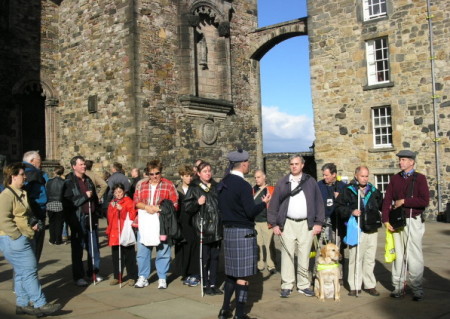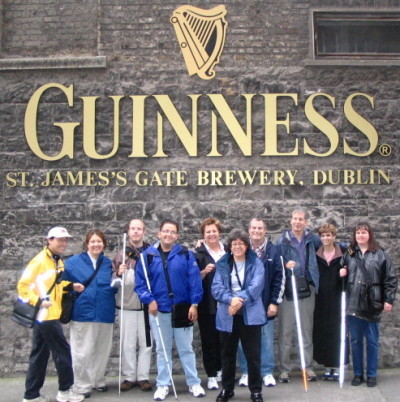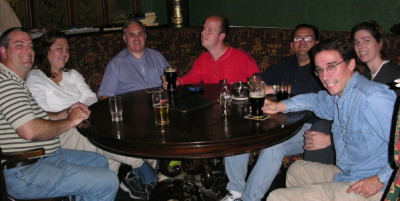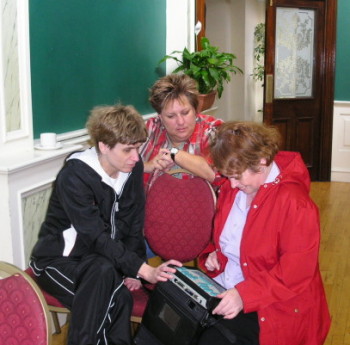By Mark Pighin, President, Mount Diablo Chapter
 |
|
Visiting an historic Dublin castle.
|
On Sept. 16, 2004 a large group of us left for an adventure to independently travel around Ireland and Scotland combining the latest BrailleNote GPS technology and our good old white canes. This turned out to be an excellent marriage because the GPS system gave many of us the confidence and desire to strike out in an unfamiliar country and explore to our hearts content, and the white cane gave us the ability to do so safely and easily.
This group included our treasurer Carl Simmons, his wife Elaine, Mike May from Sendero Group (developer of the BrailleNote GPS system), and 16 others. The primary purpose of our trip was to have fun and eat a lot of wonderful food, drink at all the pubs, and meet a lot of friendly people. Since we all had differing ideas of what we wanted to do and see, we usually split up into small groups and did our own things. This was possible with the assistance of the GPS system, which told us where we were, planned our routes, and helped us to return in time for dinner at the pub.
Each night when we arrived back at our hotel rooms we all had many new, exciting, and interesting experiences to share. It was decided that we would write accounts of our days and put them on Sendero’s web site for everyone back home who wasn’t lucky enough to join us and share our experiences firsthand.
So, Federationists, come along with us and sample our adventures in Ireland and Scotland.
On Friday, Sept. 17, our Way Fun tour group arrived in Dublin. We all arrived from our various international cities with no delay. The day was spent touring the city and getting the lay of the land and of the GPS street maps and points of interest.
By the next day, our Way Fun group of 20 was fairly rested and ready to storm Dublin with canes. Richard Bartholomew from Scotland was the only guide dog user. The laws for bringing dogs to the U.K. were recently relaxed but not quite in time for the American dog users to organize and bring their dogs.
We split up into four groups and went off in search of trouble and the more common sites of Dublin. Users of the BrailleNote GPS ranged from intermediate to advanced. Each group had at least one two-way radio with a range of a mile or so. I would check in with the groups on the radio or via mobile phone. The weather started out sunny for the second day in a row and spirits were definitely bright.
I went in search of Pete’s Electronic store to find some power adapters, plus I enjoyed the challenge of operating completely on my own. I asked lots of questions from passers-by because I learned the vicinity of the store and a street name but not an address. One benefit of the GPS is that you can find out sooner when people have given you a bum steer.
When traveling in another English-speaking country, many regional expressions are interesting. Richard told us, for example, that the older folks in Scotland use the expression “going to check messages” when we would say “going to the grocery store.” I wonder if merchant farmers originated a “bum steer”? It certainly applies to at least half of the directions one gets on the street. Maybe I don’t understand the language but it sure seems that people are even less specific here than back in the States. Anyway, thank goodness for some technology.
I eventually found the store in a rather circuitous manner. The walk back to the hotel took a third of the time and was only half the distance. I didn’t need to ask any questions since the Lynam Hotel was already in my database.
I then connected with the Kansas City group via the radio. They told me what point of interest they were near and I set that on my GPS and created a route to them. We had lunch in Temple Bar, replete with a panini and a pint.
I had to do double-time from the restaurant to the Royal Dublin Hotel where we met up with a group of 25 to 30 Dublin locals organized by the National Council of the Blind of Ireland. I gave a presentation and then the locals paired up with GPS guides from our group and we walked the streets near the hotel. Other than one Trekker user, none had prior experience with GPS. We did some interviews and all met back for conversation and libation. It was a wonderful interchange of culture and technology information.
We got lucky and secured a Saturday night reservation for 20 at Eliza Blue on the River Liffey, on the edge of the lively Temple Bar section of Dublin. Sixteen of the group walked from there to the Pedestrian Gate of Dublin Castle where we met up for the 9 p.m. Zozimus walking tour of Dublin by night. This was a very funny and educational meandering around this historic part of Dublin. We heard about the notable prisoners in the castle and about the author of Dracula, who is from Dublin. The Zozimus tour ended in a graveyard close to 11 p.m. Some of the group headed back and some of us carried on.
 |
|
A visit to the Guinness brewery.
|
We proceeded from there to O’Shea’s pub for what we thought would be Guinness and traditional Irish music. Instead, it was country music. After draining our pints there, we walked across the street to supposedly the oldest pub in Ireland, the Brazen Head, where there was more country music. We headed back to the hotel keeping our ears open for Irish music along the way. We arrived back around 1 a.m. when Dublin was just getting going.
On Monday, the taxi ride from the hotel to the Dublin Heuston station went almost smoothly. I was in a taxi with Rich and Valerie and we had some fun talking about guide dog names and the interesting responses they may trigger. Rich had GPS running and checked with the driver as to the accuracy of its information. The driver was impressed and wished he had it in the car. We then boarded a train headed to the city of Cork. When we arrived we decided to head for town, having nothing specific in mind and planning no particular time to reconnect. We decided to divide and conquer. People clustered into groups of their choosing and started walking toward town. Everyone had a BrailleNote GPS and most groups had a person with a two-way radio.
My group went on an adventure walk through the city, right through industrial Cork, through the mud. Periodically, the radio would squawk as we checked in with each other with tips about places we had discovered. Some stopped to eat while others continued to wander. Our team ended up at Raven's Bar, where we had a drink. Via the radio that connected our groups, Charles gave another group a Geocache GPS challenge: he gave them latitude and longitude information and sure enough they found us! Well-done, group! As a reward they got the opportunity to have a drink as well.
As I strolled from a cyber café back to our hotel, I was pondering these thoughts: Low expectations have a debilitating effect on the development of independence and aptitude. With no mal intent, much of the public and even some professionals in the blindness field maintain these low expectations. It is so beneficial and yet so difficult to raise expectations of blind individuals even though the result can be so life enriching. Here I was, in Cork, Ireland, a place I had never been before, and within 10 hours was feeling quite at home and very oriented. I passed some other members of our group along the way who were coming back from a restaurant. Still others were out listening to some live Irish music. And yet, we are not all amazing; we have a wide variety of personalities, travel techniques, skills, and attitudes. I wondered what the common component was that placed us in this part of the world, all enjoying ourselves and choosing the people we wanted to hang out with and the activities we wanted to pursue.
Logistically, some blind folks might naturally connect with a sighted person in the group in order to find and get to a restaurant in a brand new city. There were five fully sighted people out of our group of 20. I think I shocked the agent at the train station when he asked me if we had any sighted guides for our group and I said we kept them out of sight until we needed to drive somewhere. I am not sure if he realized I was kidding or not.
Some of the blind and sighted people in our group didn’t walk all that fast and some got easily turned around. These are not all travelers from the Orientation and Mobility Olympics, yet people were heading out the door of that Washington Street Pub whenever they wanted. In fact, when we were in Dublin and did walk to a restaurant as a group, we arrived there minus two people. I was worried but they were industrious and eventually found us.
I really felt a glow as I walked along the busy Western Road toward the guest house late at night; not from too much Guinness but from the realization that all these folks with different skills and personalities shared the expectation that they could do what they wanted, with whom they wanted—some more slowly than others, some getting lost, many getting frustrated—but everyone thirsty to explore and experience the culture and the city. We were all inspired by each other. The fact that the O&M bar was set high by the group challenged all of us to exceed our personal bests.
On Tuesday, some folks went to kiss the Blarney Stone, some took a bus to a seaside village of Kinsale, and I headed for the Cork City Gaol, an historical jail, with Valerie with another group following. We wanted to find it ourselves based on very vague directions from a passing tourist. She told us it was up very steep hills, implying we might not be able to make it.
Our guesses of when to cross streets and when to turn ended up being right on. The GPS was running but we didn’t have an address or point of interest to shoot for so we stopped the few people we met along the way and kept getting confirmation we were headed in the correct direction. It was in a very residential area so there weren’t many people to ask. We did find it, long before the group with the sighted folks in it, but we aren’t boasting; just pleased that we got there in one piece and without spending the whole day looking for it.
On Wednesday, we managed to make the transition from the Killarney Guest House in Cork to the Corkaigh Airport without losing any people or bags. Check-in was a breeze, as was security. The fun came when we lined up to board the Air Erin flight to Edinburgh. All of a sudden the gate agents were asking who was blind and how many of us were totally blind, visually impaired, or fully sighted. Jason said that the other low-cost airline, Ryan Air, expressly has a limit of two disabled people per flight. Air Erin said they didn’t have such a limit. I guess they need the business. However, they decided that their policy manual did not allow two blind people to sit together. I tried to convince them that the blind people would lead the way out of the airplane if the cabin was smoky but they didn’t buy this argument. So, they delayed the departure as they reassigned us seats. Many of us were inclined to make a stink but we also wanted to get to Edinburgh. It wasn’t as though we would be flying this airline regularly.
 |
|
One of several enjoyable trips to the pub.
|
Paul and Cathy Shelton, both blind, did some quick thinking. Cathy gave her cane to Theresa, who is sighted, in order that Cathy could sit with her husband. This gives me some satisfaction that Air Erin didn’t have the last word on this absurd policy.
After landing in Edinburgh, we took a train to Kirkcaldy, about a 45-minute trip. The logistics of three taxis, one airplane and one train with all of our luggage was taxing on those who had a lot of luggage and those helping out. There isn’t a lot of time when a train pulls in or drops off for one to grab bags and get situated. This is made even trickier when it is crowded and you have several blind people trailing. Most of Wednesday was spent traveling, and when people arrived in Kirkcaldy they were more than ready for a break and some food.
A couple of us just made the early train in order to meet with the Fife Society for the Blind at their base in Kirkcaldy. It was interesting to learn about their services in the region and especially to get restaurant and entertainment tips from the locals. Having been on transport all day, we set a pedestrian route and walked the 1.2 miles from the hotel to FSB. We negotiated two roundabouts and at least 10 turns out of 14 waypoints. This was through mostly residential areas. We did have a sighted person with us, thankfully, for the roundabout crossing; however, it was strictly up to the GPS and those operating it to direct us to the address on Wilson Avenue.
On Thursday we took the express train from Kirkcaldy to the Waverley district of Edinburgh, about 20 minutes. We split up and shopped in the area. I was with Ilona and Rich Irwin when a woman came out of a store and said, “Didn’t I hear about you this morning on the radio? Aren’t you Americans testing a satellite system?” I said we were, plus one Dutch person. Her name was Julie, and we fell into conversation as we walked along the streets. She told us about the best places to shop and we told her the names of the streets we were crossing. Julie left us in an indoor mall and a nice sales person escorted us around various shops (not just her own) looking for some gift items. It was great meeting and visiting with a couple Scottish locals. From there, Rich and I managed to get lost for a while in a parking garage before we made our way to our group appointment at the new Parliament building.
A Member of Scottish Parliament, Kate MacLean, hosted us. We got a brief tour and had some discussions about issues for blind people in the U.K. From Parliament, we strolled along the Royal Mile toward the Edinburgh castle. I did several media interviews in person and on the phone, along with a stop for lunch. The castle was very interesting with excellent audio and live guides. My favorite factoid was the biggest cannon shot: a 350-pound boulder. We saw royal jewels, swords and mostly enjoyed the history and ambiance of the castle. As usual, we ended the evening with a fantastic meal and a quest for bed after a very full day.
On another beautiful day in Kirkcaldy, we set out in several different directions. One group went to the seaside, another to Saint Andrews to see the famous golf courses, while others stayed in town and some returned to Edinburgh, where Jason was the subject of articles by the Scotsman and the Edinburgh Evening News. Six of us took the Majestic City bus tour to get an overview of Edinburgh. It is a fairly cosmopolitan city as compared with Glasgow.
We all gathered again in the evening to have dinner in the nearby village of Fruechie. It was our last night with the entire group since some folks were flying out of Glasgow and staying there tomorrow night. We took over the restaurant hotel and had traditional Scottish food. Some even had the famous Haggis, Neeps and Tatties. If you don’t think about what Haggis is, it isn’t so bad. Several folks were game.
I spent most of the next day with a film crew in Weymss which was doing a story about Richard Moore, a man blinded at age 10 by a stray bullet in Belfast. Richard is thinking about having an operation to restore his site, as I did. We were comparing notes about the issues he might face. Like me, Richard agreed that it was the journey that interested him, not that he needed to have vision, in order to be a complete person. I am speaking about the journey to explore the meaning of blindness, low-vision and full-vision.
 |
|
Exploring Ireland using the BrailleNote and GPS technology.
|
Richard just flew in from Malawi where he was visiting one of the divisions of his foundation, Children In Crossfire. He still lives in Darry, Northern Ireland and he travels the world from Africa to South America on behalf of his foundation.
We both expressed gratefulness for the lives we have been fortunate to lead in spite of the accidents that blinded us. How many people in the world have a good job, family, and opportunity to travel like we do? Blind, that is “mice nuts” compared with the plight of children in developing countries facing daily violence, or even people who struggle with alcoholism or are homeless. We wondered what the big deal was about blindness in the face of so many other plights. Here we were, two blind men, meeting on the shores of Scotland, one flying in from California and the other from Northern Ireland arriving from Africa just in time for this meeting.
I am sure all of the travelers in our group, blind and sighted, were incredibly grateful for the fact that we had the tools, techniques and where-with-all to be able to vacation in Dublin, Cork and Fife. In the modern vernacular, “How cool is that?”
Margaret and Armand reported another successful day on their own, locating Tate’s Jewelry Store, a place where losing pounds isn’t hard to do. Margaret was justifiably proud that she and Armand found Rose Street and the jewelry store independently with the help of the GPS.
I felt a tinge of sadness as the trip drew to a close and there were no more opportunities to toast as a group and to say goodbye. We created unforgettable experiences and made new friends in our mere 10 days of traveling. Instead of saying goodbye, we said, “Where are we going next?”
Reflecting back on our trip, I see it as another example of the philosophy that we as Federationists hold so dearly. We were able to travel independently in two countries with no limitations due to our blindness. I firmly believe based on our trip that it is important for us to master and take advantage of new technology as well as tried-and-true basic blindness skills, as they can closely compliment each other, thereby increasing the options available to us. I hope that our trip can inspire one of you to get out there and take the trip that you have always wanted to take. We as a group have proven that it is possible.